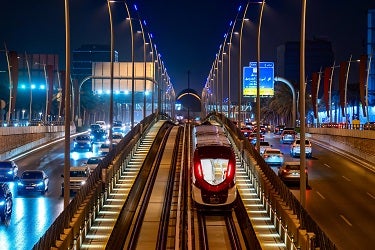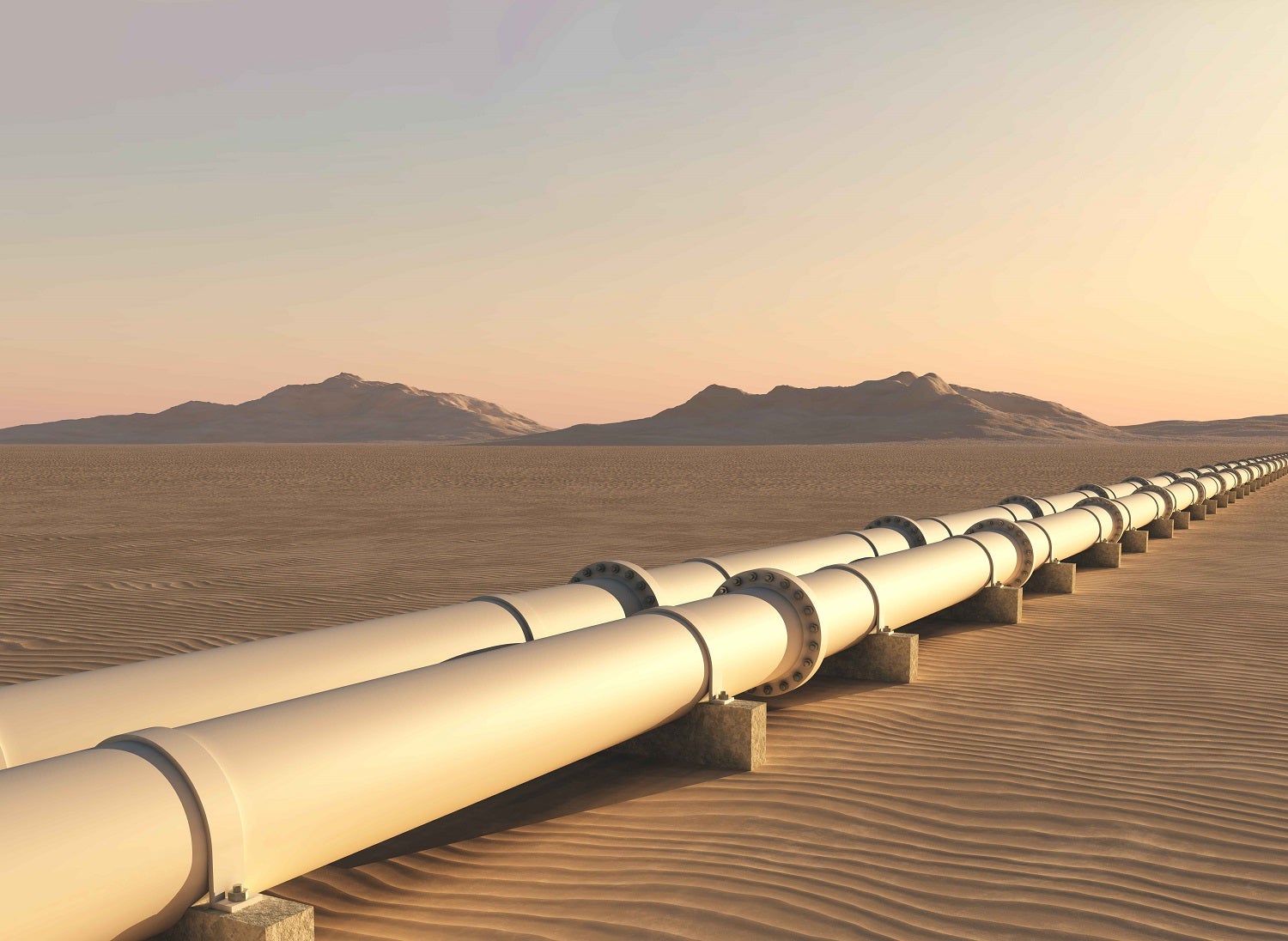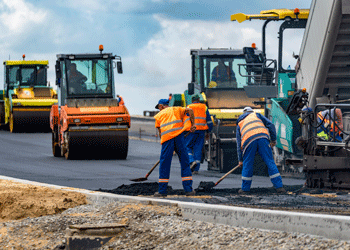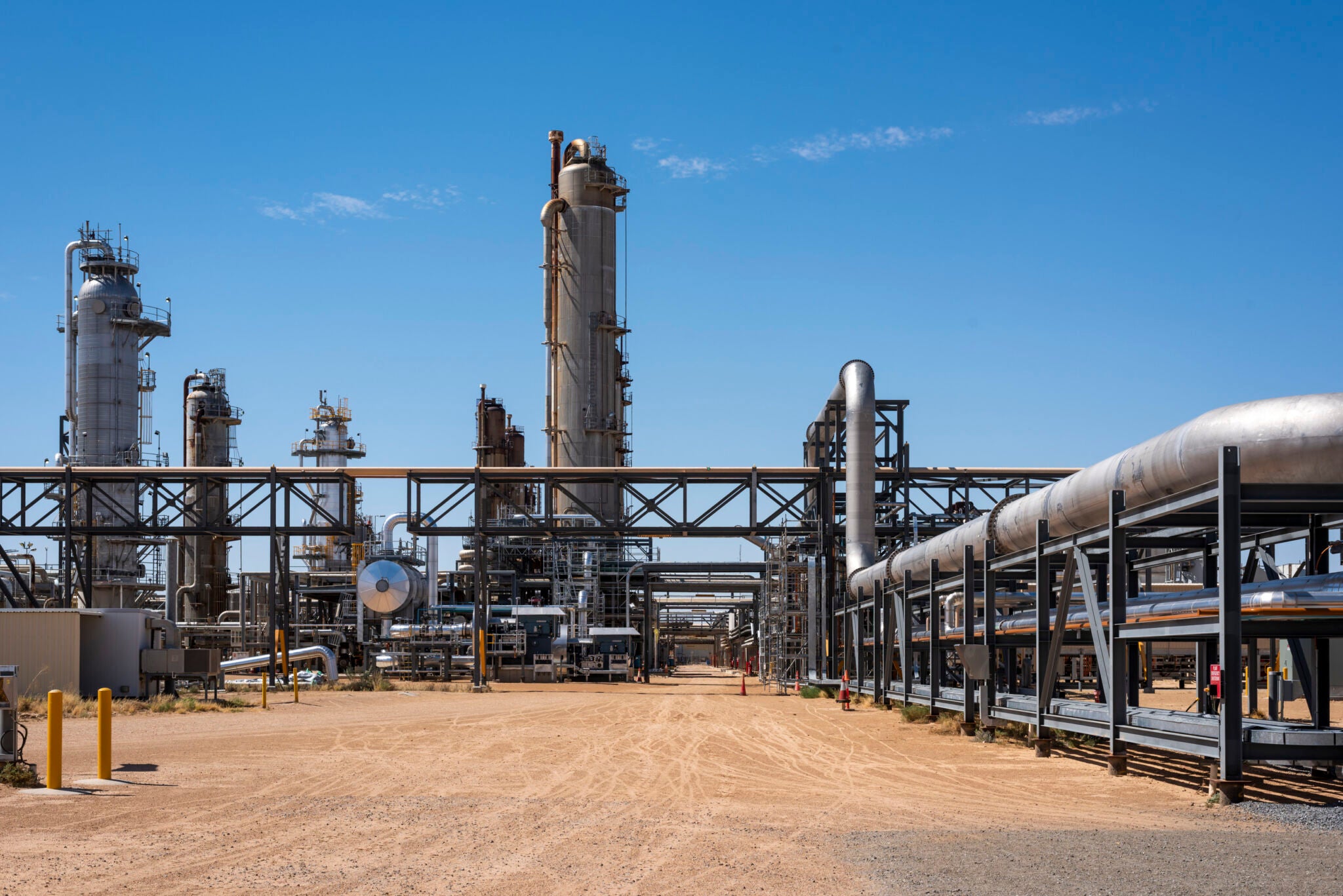Region plays high-stakes AI game
11 June 2024
This package also includes: Data centres meet upbeat growth
Artificial intelligence (AI) is a potential enabler for the economic diversification programmes of the GCC’s hydrocarbons-exporting states.
The UAE launched an open-source large-language model (LLM) last year. Falcon 40B, shortly followed by Falcon 180B, cemented the reputation of the Abu Dhabi government-funded Technology Innovation Institute as a major player in generative AI.
With 180 billion parameters and trained on 3.5 trillion tokens, Falcon 180B soared to the top of the Hugging Face Leaderboard, a benchmark for pre-trained LLMs. Falcon 180B outperformed competitors such as Meta’s Llama 2 in areas including reasoning, coding, proficiency and knowledge tests.
The launch of Falcon followed cumulative investments in research, talent acquisition and digital infrastructure. In recent years, Abu Dhabi has formed government-attached agencies and commercial entities backed by its sovereign wealth funds to focus on AI.
One such company is G42, which has partnered with the US’ OpenAI to develop sector-focused generative AI models, and with Microsoft to run applications on Azure and undertake AI skilling initiatives in the UAE and beyond.
Global AI hubs
The UAE aims to become a world-leading AI hub alongside the US and China, but the country will have to tread carefully when choosing partners to avoid geopolitical complications involving its most important security ally and its largest energy client.
Riyadh seems determined to give Abu Dhabi a run for its AI money. The GCC region’s two largest states have placed
separate multimillion-dollar orders for graphics processing units – powerful chips designed for training AI – from top US supplier Nvidia.
They have also formed AI-focused investment vehicles with a view to maximising investments and returns from AI ventures at home and abroad. Abu Dhabi formed MGX, which aims to build $100bn in assets under management within a few years, while Saudi Arabia’s Public Investment Fund formed a $100bn platform to transform the kingdom into a semiconductor and electronics hub, with AI playing a central role in the plan.
In May this year, the Saudi Data & Artificial Intelligence Authority and New York-based technology company IBM launched an open-source Arabic LLM called Allam on IBM’s Watsonx AI and data platform.
With AI promising to be a $1tn market by 2030, it offers attractive opportunities
Computer power
A potential issue facing the determined push for AI leadership is that AI requires enormous computational power and energy, in addition to vast capital and talent.
A recent article published by the World Economic Forum (WEF) suggests that the computational power required to sustain the rise of AI doubles approximately every 100 days.
Related read: Global AI market to top $1tn in 2030
“The energy required to run AI tasks is already accelerating with an annual growth rate between 26% and 36%. This means by 2028, AI could be using more power than the entire country of Iceland used in 2021,” the WEF article says.
The AI lifecycle impacts the environment in two stages. First is the training phase, when the models learn and develop by digesting vast amounts of data; and second is the inference phase, when they solve real-world problems.
At present, the environmental footprint is split, with training responsible for about 20% and inference taking up 80%.
“As AI models gain traction across diverse sectors, the need for inference and its environmental footprint will escalate,” the WEF warns.
A peer-reviewed analysis in the science journal Joule says that a continuation of the current trends in AI capacity and adoption will likely result in Nvidia shipping 1.5 million AI server units a year by 2027.
When running at full capacity, these servers are expected to consume at least 85.4 terawatt-hours of electricity annually, which is equivalent to 100GW of installed capacity in the next three years.
Data centres, which make up the main AI digital infrastructure, already account for about 1%-1.5% of global electricity use.
In a hypothetical scenario in which everyone shifts to AI for mundane tasks such as performing searches on Google, every data centre would effectively experience a 10-fold increase in energy consumption, according to Alex De Vries, a data scientist at the Central Bank of the Netherlands, which conducted the analysis published by Joule.
As a result, the hydrocarbons-exporting and energy-transitioning GCC states – particularly the UAE and Saudi Arabia – appear to be a natural fit for AI, due to the presence of abundant and cheap fossil-fuel or renewable-energy resources, and the need to diversify their revenue sources away from oil. With AI promising to be a $1tn market by 2030, it offers attractive opportunities.
According to a Dubai-based senior executive with a global infrastructure investor, each country and company will eventually need to consider what part they can play in the AI value chain.
Since Nvidia seems to have captured the microprocessor space, the other areas of opportunity are in developing computing power, algorithms and implementation. “Both Saudi Arabia and the UAE have the theoretical capability to grow into the computing power and implementation spaces, which require computing capacity through data centres and medium-skilled manpower to deploy, migrate, train and maintain [AI],” the executive says.
Greening AI
Policy adjustments could be needed to support such advances, especially when it comes to minimising AI’s carbon footprint, even as it enables the curbing of those in other sectors – including the power sector.
In addition to the vast computing and wattage requirements of AI, the region’s arid weather and very hot summer temperatures mean that regional data centres have greater cooling requirements.
To address this, the Dubai state utility has started to build a solar-powered data centre, which is understood to be the first of its kind in the world.
Saudi Arabia, which aims to have 58.7GW of renewable energy installed capacity by 2030 – accounting for about 50% of its electricity production mix – could follow a similar model.
Abu Dhabi’s quantum computer project, in partnership with researchers at Spain’s Qilimanjaro Quantum Tech, is under way.
Unlike a classic supercomputer that operates on binary states, a quantum computer uses quantum mechanics phenomena including superposition and entanglement to generate and manipulate subatomic particles such as electrons or photons, or qubits.
This allows greater processing powers that can enable the performance of complex calculations that would take much longer to be solved, consuming less power than a supercomputer.
The growing electricity surplus in Abu Dhabi, as all four reactors at the Barakah nuclear power plant come onstream this year, could also be allocated to data centres and AI applications.
In addition, Abu Dhabi’s plan to start procuring phase two of its Barakah nuclear energy plant may not only boost energy exports, but could also create sufficient margins to accommodate future AI computing demand.
Related read: Nuclear power will help region achieve AI ambitions
“I don’t know if that means only nuclear power can solve the demand, but it certainly is a good option and carries some strategic advantage as well,” says Karen Young, senior research scholar at Columbia University’s Centre on Global Energy Policy.
While AI needs a significant amount of electricity for computations, there should be savings through productivity increases
Efficiency gains
While it is difficult to accurately quantify and forecast AI’s overall carbon emissions, a holistic view of its overall environmental impact is required.
In theory, while AI itself needs a significant amount of electricity for computations, there should be savings through productivity increases. “Will people need to go to the office less often, and how about the improved performance of machines?” asks the Dubai-based infrastructure investor.
However, it is also important not to overstate AI’s potential benefits to the region’s economies. While AI could be a major driver of economic diversification, Young has yet to be convinced that it will significantly boost the GCC’s GDP growth.
Job creation is a vital element of economic diversification, she tells MEED, but AI is often used to replace roles in the service sector and lower-skilled opportunities, such as those in the retail banking sector. This could impact efforts under way in several GCC states to boost employment among citizens, such as the Saudi Nationalisation Programme and the UAE’s Emiratisation drive.
On the upside, however, AI can be very good at improving efficiencies in the oil and gas industry and the power sector, and at boosting productivity.
The need of the hour appears to be establishing a clear path towards efficient AI deployment, despite the fact that the results of the technology’s full-fledged implementation remain hard to ascertain.
“The UAE is doing a lot to attract skilled people to provide more value-added services, but that is an organic process and needs a more vibrant ecosystem of education institutions – and companies establishing more than just sales offices – to be truly called a hub,” the infrastructure investor tells MEED. “Saudi Arabia is still a bit far from that.”
Exclusive from Meed
-

-

-
 Bahrain and US sign nuclear energy agreement
Bahrain and US sign nuclear energy agreement17 July 2025
-
 Kuwaiti firm wins $53m Duqm coastal road contract
Kuwaiti firm wins $53m Duqm coastal road contract17 July 2025
-

All of this is only 1% of what MEED.com has to offer
Subscribe now and unlock all the 153,671 articles on MEED.com
- All the latest news, data, and market intelligence across MENA at your fingerprints
- First-hand updates and inside information on projects, clients and competitors that matter to you
- 20 years' archive of information, data, and news for you to access at your convenience
- Strategize to succeed and minimise risks with timely analysis of current and future market trends

Related Articles
-
 Riyadh Royal Commission awards metro Line 2 extension
Riyadh Royal Commission awards metro Line 2 extension18 July 2025

Register for MEED’s 14-day trial access
Saudi Arabia’s Royal Commission for Riyadh City (RCRC) has awarded an estimated $800m-$900m contract to build the next phase of the Riyadh Metro project, which is the Line 2 extension.
The contract was awarded to the Arriyadh New Mobility Consortium.
The Line 2 extension is 8.4 kilometres (km) long, of which 1.3km is elevated and 7.1km is underground. It includes five stations – two elevated and three underground.
It will run from where Line 2 currently ends at King Saud University (KSU) and then travel onwards to new stations at KSU Medical City, KSU West, Diriyah East, Diriyah Central, where it interchanges with the planned Line 7, and then finally to Diriyah South.
According to the consortium’s official website, the consortium members include Italy’s Webuild, India’s Larsen & Toubro, locally based Nesma & Partners, Japan’s Hitachi, Italy’s Ansaldo STS, the Canadian firm Bombardier, Spain’s Idom and WorleyParsons from Australia.
In 2013, the Arriyadh New Mobility Consortium secured Riyadh Metro’s Line 3 project for $5.21bn.
Line 3, also known as the Orange Line, stretches from east to west, from Jeddah Road to the Second Eastern Ring Road, covering a total distance of 41km.
Riyadh Metro
Riyadh Metro’s first phase features six lines with 84 stations.
The RCRC completed the phased rollout of the Riyadh Metro network when it started operating the Orange Line on 5 January.
In December last year, the RCRC started operating the Red Line and Green Line.
The Red Line, also known as Line 2, stretches 25.1km from the east of Riyadh to the west, via King Abdullah Road, connecting King Fahd Sports City and King Saud University. It has a total of 15 stations.
The Green Line, also known as Line 5, extends 13.3km from King Abdullah Road to the National Museum. With 12 stations, it serves several ministries and government agencies, including the Defence Ministry, the Finance Ministry and the Commerce Ministry, as well as other areas.
Earlier in December, the RCRC started operating the Blue Line (Line 1), Yellow Line (Line 4) and Purple Line (Line 6).
The Blue Line connects Olaya Street to Batha; the Yellow Line runs along King Khalid International Airport Road; while the Purple Line connects Abdul Rahman Bin Awf Road with Al-Sheikh Hassan Bin Hussain Road.
King Salman Bin Abdulaziz Al-Saud inaugurated the Riyadh Metro on 27 November last year.
The network spans 176km. Four of the stations have been designed by signature architects.
The metro is part of the Riyadh Public Transport Project, which encompasses metro and bus systems. The project aims to relieve traffic congestion.
The $23bn project was scheduled to open in 2018, but construction activity slowed due to disputes over prolongation and the disruption caused by the Covid-19 pandemic.
The RCRC awarded the main construction packages for the scheme on 28 July 2013.
In November 2022, the RCRC struck a deal with three contracting consortiums working on the Riyadh Metro scheme regarding the completion of the project’s remaining works.
The Fast consortium won lines 4, 5 and 6, reportedly valued at $7.82bn. The Bacs consortium was awarded lines 1 and 2 for $9.45bn, while Arriyadh New Mobility secured Line 3 for $5.21bn.
US firm Bechtel leads the Bacs consortium. Italian firm Ansaldo STS is the leader of the Arriyadh New Mobility group, and Spanish firm FCC Construccion heads the Fast consortium.
AtkinsRealis has delivered programme management and supervision services for the operations and maintenance of the Riyadh Metro scheme.
https://image.digitalinsightresearch.in/uploads/NewsArticle/14289337/main.jpg -
 Firms submit bids for Maaden gold project water pipeline
Firms submit bids for Maaden gold project water pipeline17 July 2025

Saudi Arabian Mining Company (Maaden) has received proposals from local firms for a water pipeline network it plans to build as part of a larger project to develop a new gold mining and processing facility in the Al-Rjum region of the kingdom.
The Al-Rjum gold mining and processing facility, located in Medina province, is expected to be commissioned by the end of 2027. It will become the largest gold mining operation in Saudi Arabia when operational.
According to sources, the pipeline is to be developed using a build-own-operate-transfer (BOOT) model. The engineering, procurement and construction (EPC) works will have a duration of 38 months, followed by a 20-year operations and maintenance period.
Lamar Holding and Alkhorayef are understood to be the only bidders for the proposed Taif to Al-Rjum water pipeline, which forms package B of the Maaden gold mining project.
The two contractors submitted bids for the water pipeline project on 1 July, sources told MEED.
The main scope of work involves building a 150-kilometre pipeline that will supply treated sewage effluent water to the Al-Rjum gold mining facility.
ALSO READ: Saudi Arabia issues mining exploration licences
The Al-Rjum gold mining and processing facility will have an output capacity of 250,000 ounces of gold a year. The project will increase Maaden’s total gold production to 700,000 ounces a year by 2028, helping the company support Saudi Arabia’s overall goal of doubling gold production by 2030 and achieving a four-fold increase in output by 2040.
MEED recently reported that Maaden had received bids for a tender to develop accommodation facilities for over 4,500 of its workers at the upcoming Al-Rjum gold mining and processing facility.
Bids for the Al-Rjum worker accommodation tender, which is also under the BOOT model, were submitted in late June. The operations and maintenance period for this contract is 15 years.
ALSO READ: Saudi Arabia and Oman open up their minerals potential
https://image.digitalinsightresearch.in/uploads/NewsArticle/14284263/main3503.jpg -
 Bahrain and US sign nuclear energy agreement
Bahrain and US sign nuclear energy agreement17 July 2025
Bahrain and the US have signed a cooperation agreement covering the field of peaceful nuclear energy.
The agreement aims to enhance collaboration in nuclear energy, recognising its vital role in sustainable development and energy security. It aligns with Bahrain's ambitious goal of achieving carbon neutrality by 2060 and contributes to global efforts to combat climate change.
As Bahrain explores alternative energy sources, senior officials have previously indicated to MEED that they are closely monitoring developments in small modular reactor (SMR) technology. This is particularly crucial for Bahrain, where limited land availability poses challenges for solar energy projects. Floating solar plants have been identified as a potential solution, but the exploration of nuclear energy and SMRs remains a priority for future energy diversification.
The agreement was signed during an official visit to the US by Prince Salman Bin Hamad Al-Khalifa, the crown prince and prime minister of Bahrain.
The agreement was formalised by Abdullatif Bin Rashid Al-Zayani, Bahrain’s minister of foreign affairs, and Marco Rubio, the US secretary of state.
Al-Zayani added that the agreement builds upon the Comprehensive Security Integration and Prosperity Agreement (C-SIPA) signed in 2023. The agreement aims to strengthen cooperation in defence, security, emerging technologies, trade and investment.
 READ THE JULY 2025 MEED BUSINESS REVIEW – click here to view PDF
READ THE JULY 2025 MEED BUSINESS REVIEW – click here to view PDFUAE and Turkiye expand business links; Renewed hope lies on the horizon for trouble-beset Levant region; Gulf real estate momentum continues even as concerns emerge
Distributed to senior decision-makers in the region and around the world, the July 2025 edition of MEED Business Review includes:
> AGENDA: UAE-Turkiye trade gains momentum> INTERVIEW 1: Building on UAE-Turkiye trade> INTERVIEW 2: Turkiye's Kalyon goes global> INTERVIEW 3: Strengthening UAE-Turkiye financial links> INTERVIEW 4: Turkish Airlines plans further growth> CURRENT AFFAIRS: Middle East tensions could reduce gas investments> GCC REAL ESTATE: Gulf real estate faces a more nuanced reality> PROJECTS MARKET: GCC projects market collapses> INTERVIEW 5: Hassan Allam eyes role in Saudi Arabia’s transformation> INTERVIEW 6: Aseer region seeks new investments for Saudi Arabia> LEADERSHIP: Nuclear power makes a global comeback> LEVANT MARKET FOCUS: Levant states wrestle regional pressures> GULF PROJECTS INDEX: Gulf projects index continues climb> CONTRACT AWARDS: Mena contract award activity remains subdued> ECONOMIC DATA: Data drives regional projects> OPINION: A farcical tragedy that no one can endTo see previous issues of MEED Business Review, please click herehttps://image.digitalinsightresearch.in/uploads/NewsArticle/14281751/main.jpeg -
 Kuwaiti firm wins $53m Duqm coastal road contract
Kuwaiti firm wins $53m Duqm coastal road contract17 July 2025
Kuwaiti contractor Combined Group Contracting Company (CGCC) has won a RO20.6m ($53m) contract to construct coastal roads in Duqm.The scope of work covers the construction of roads with a total length of 14 kilometres, including a coastal road, a proposed service road, an extension to an existing service road, a resort street, four roundabouts, future extensions and proposed links.
The contract duration is two years from the start date of construction.
MEED reported in August 2023 that CGCC had emerged as the lowest bidder for the project.
GlobalData estimates that the construction industry in Oman will grow by 3.6% in real terms in 2025, supported by rising foreign direct investment (FDI) in the country, particularly in the manufacturing sector, as well as investment in the energy and transport sectors.
The infrastructure construction sector is estimated to grow by 5.7% in 2025, before recording an annual average growth of 5.2% between 2026 and 2029, supported by the government’s investment in upgrading road and airport infrastructure.
CGCC’s contract win in Oman comes shortly after a key contract win in the UAE, worth AED685m ($186m).
The scope of work under this contract encompasses the upgrade works on Emirates Road, from the Al-Badea intersection in Sharjah to the E55 intersection in Dubai.
The UAE’s Ministry of Energy & Infrastructure is the project client.
The contract duration is 25 months.
 READ THE JULY 2025 MEED BUSINESS REVIEW – click here to view PDF
READ THE JULY 2025 MEED BUSINESS REVIEW – click here to view PDFUAE and Turkiye expand business links; Renewed hope lies on the horizon for trouble-beset Levant region; Gulf real estate momentum continues even as concerns emerge
Distributed to senior decision-makers in the region and around the world, the July 2025 edition of MEED Business Review includes:
> AGENDA: UAE-Turkiye trade gains momentum> INTERVIEW 1: Building on UAE-Turkiye trade> INTERVIEW 2: Turkiye's Kalyon goes global> INTERVIEW 3: Strengthening UAE-Turkiye financial links> INTERVIEW 4: Turkish Airlines plans further growth> CURRENT AFFAIRS: Middle East tensions could reduce gas investments> GCC REAL ESTATE: Gulf real estate faces a more nuanced reality> PROJECTS MARKET: GCC projects market collapses> INTERVIEW 5: Hassan Allam eyes role in Saudi Arabia’s transformation> INTERVIEW 6: Aseer region seeks new investments for Saudi Arabia> LEADERSHIP: Nuclear power makes a global comeback> LEVANT MARKET FOCUS: Levant states wrestle regional pressures> GULF PROJECTS INDEX: Gulf projects index continues climb> CONTRACT AWARDS: Mena contract award activity remains subdued> ECONOMIC DATA: Data drives regional projects> OPINION: A farcical tragedy that no one can endTo see previous issues of MEED Business Review, please click herehttps://image.digitalinsightresearch.in/uploads/NewsArticle/14281451/main.gif -
 Algeria awards $855m contract for gas production project
Algeria awards $855m contract for gas production project17 July 2025
Register for MEED’s 14-day trial access
Algeria’s national oil and gas company Sonatrach has awarded an $855m contract to China’s Jereh Group for a project to develop facilities at the Rhourde Nouss gas field.
Jereh Group said that its subsidiary Jereh Oil & Gas Engineering will build a natural gas booster station in the Rhourde Nouss gas field and upgrade and renovate related transmission pipelines.
The Yantai-based company cited a letter of award from Sonatrach and said that the contract will boost the company's footprint in North Africa’s oil and gas engineering service sector.
The Rhourde Nouss boosting project will centralise the boosting of natural gas produced by the gas field and the adjacent Gassi Touil gas field, to improve their production efficiency and natural gas processing capacity, the company said.
Sonatrach, the largest gas producing company in Africa and the largest state-owned enterprise in Algeria, will pay $629.1m and $226m for the construction of the project, Jereh said.
Jereh's growing footprint
Jereh has been expanding overseas in recent years and has won contracts with major Middle Eastern oil and gas clients, including Saudi Aramco, Abu Dhabi National Oil Company (Adnoc) and Kuwait Petroleum Corporation.
In June 2021, the company was awarded a contract for the design, procurement and construction of a gas debottlenecking project in Algeria.
The project was located in the Bir Rebaa Nord and Rhourde Ouled Djemma fields, which are located in the eastern Algerian desert, about 300 kilometres southeast of Hessi Messaoud.
The client on that project was Groupement Sonatrach Eni, a joint venture of Sonatrach and Italian energy company Eni.
 READ THE JULY 2025 MEED BUSINESS REVIEW – click here to view PDF
READ THE JULY 2025 MEED BUSINESS REVIEW – click here to view PDFUAE and Turkiye expand business links; Renewed hope lies on the horizon for trouble-beset Levant region; Gulf real estate momentum continues even as concerns emerge
Distributed to senior decision-makers in the region and around the world, the July 2025 edition of MEED Business Review includes:
> AGENDA: UAE-Turkiye trade gains momentum> INTERVIEW 1: Building on UAE-Turkiye trade> INTERVIEW 2: Turkiye's Kalyon goes global> INTERVIEW 3: Strengthening UAE-Turkiye financial links> INTERVIEW 4: Turkish Airlines plans further growth> CURRENT AFFAIRS: Middle East tensions could reduce gas investments> GCC REAL ESTATE: Gulf real estate faces a more nuanced reality> PROJECTS MARKET: GCC projects market collapses> INTERVIEW 5: Hassan Allam eyes role in Saudi Arabia’s transformation> INTERVIEW 6: Aseer region seeks new investments for Saudi Arabia> LEADERSHIP: Nuclear power makes a global comeback> LEVANT MARKET FOCUS: Levant states wrestle regional pressures> GULF PROJECTS INDEX: Gulf projects index continues climb> CONTRACT AWARDS: Mena contract award activity remains subdued> ECONOMIC DATA: Data drives regional projects> OPINION: A farcical tragedy that no one can endTo see previous issues of MEED Business Review, please click herehttps://image.digitalinsightresearch.in/uploads/NewsArticle/14278458/main.jpg

 Data centres meet upbeat growth
Data centres meet upbeat growth